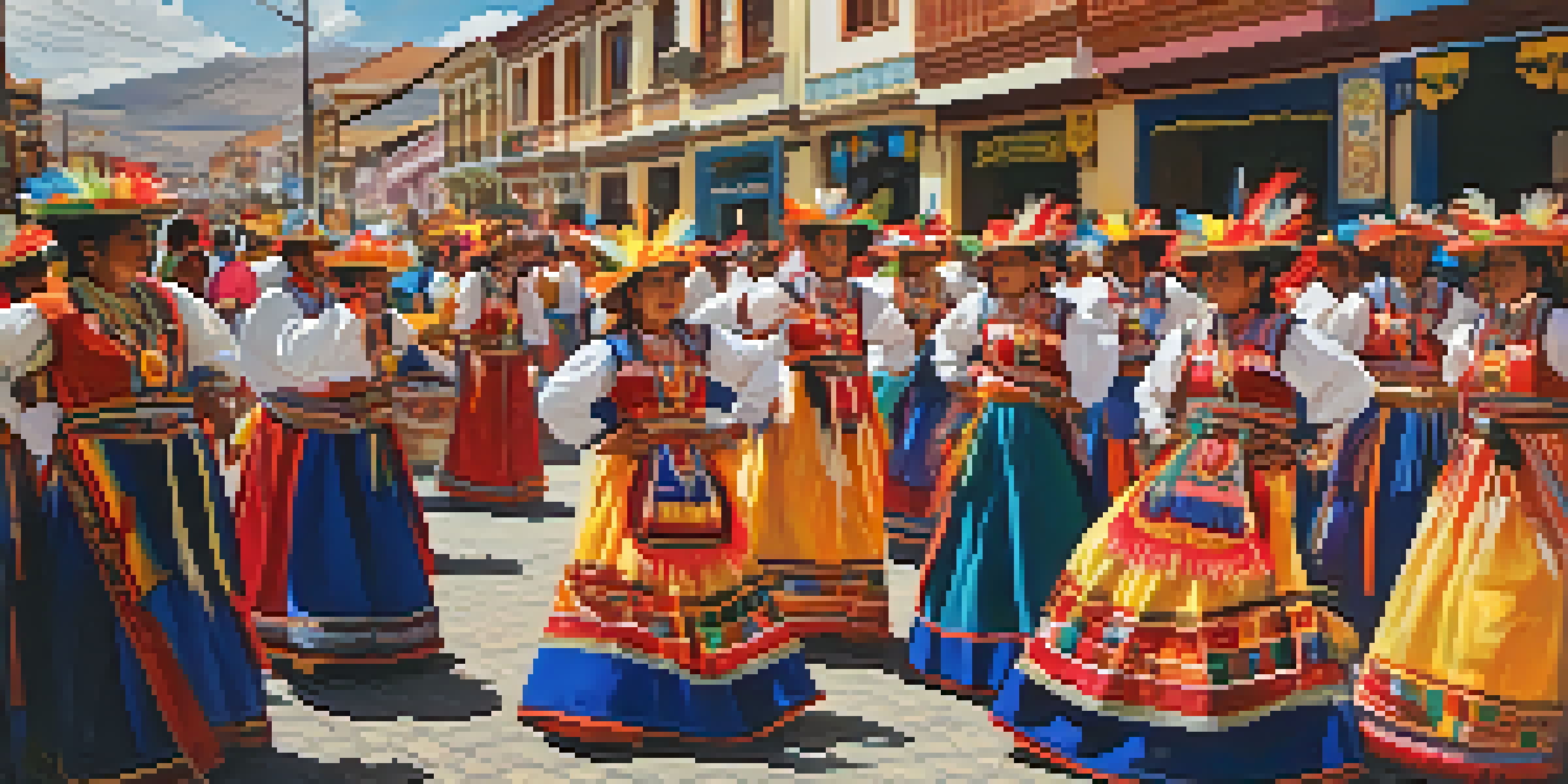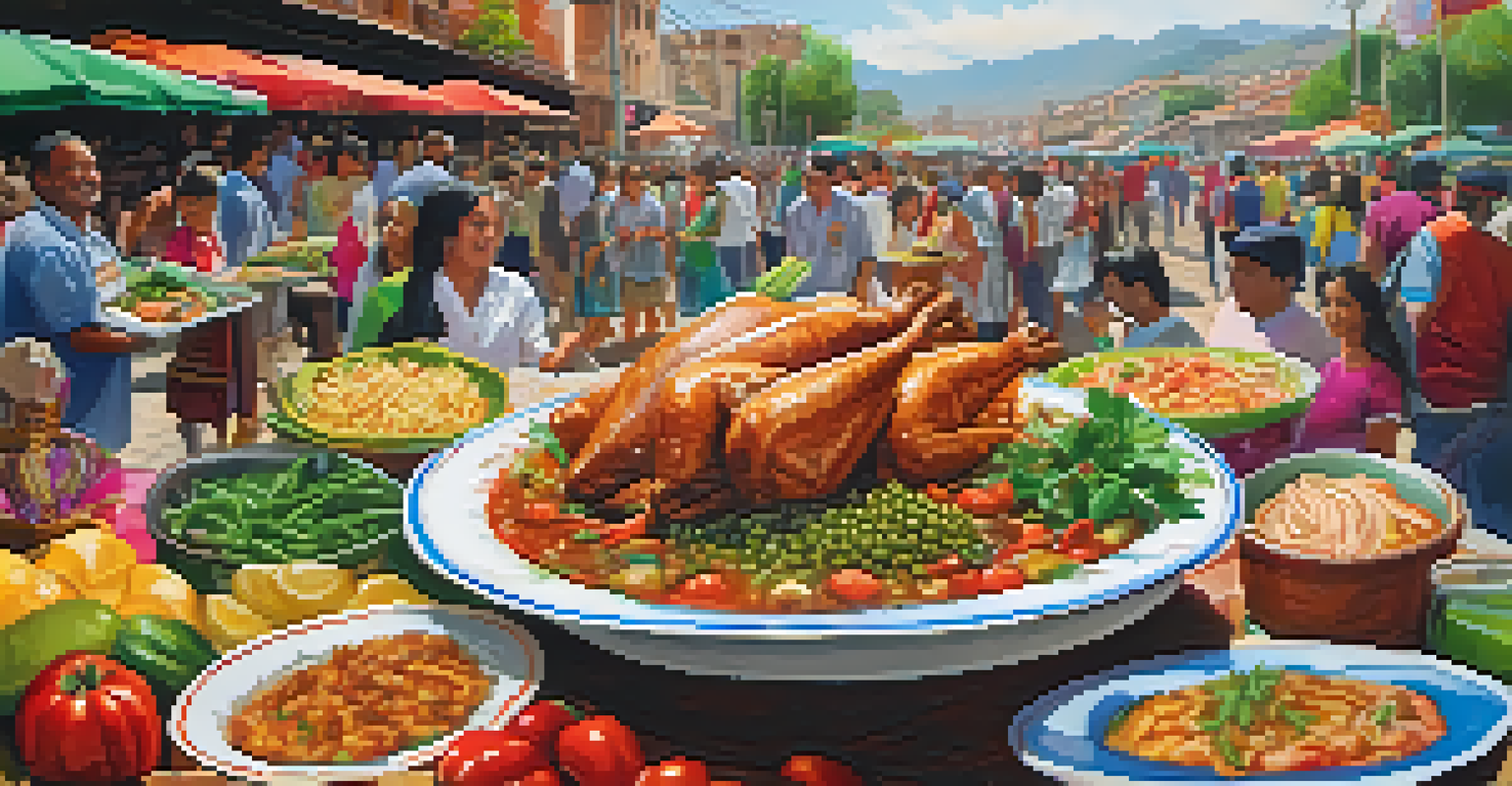Puno's Fiesta de la Virgen de la Candelaria Celebration

Introduction to the Fiesta de la Virgen de la Candelaria
The Fiesta de la Virgen de la Candelaria is one of Peru's most vibrant and colorful celebrations, held annually in the city of Puno. This festival, rich in traditions, honors the patroness of Puno, the Virgin of Candelaria, and draws thousands of visitors from around the world. The event typically takes place in early February, marking a time of joy, music, and cultural pride for the locals.
Tradition is not the worship of ashes, but the preservation of fire.
As the festival approaches, the city transforms into a lively hub filled with parades, music, and dance. Participants, dressed in traditional costumes, take to the streets to showcase their cultural heritage. The atmosphere is electric, with the sound of Andean music filling the air and creating an inviting ambiance for both locals and tourists alike.
In essence, the Fiesta de la Virgen de la Candelaria is not just a religious event; it's a celebration of Puno's identity and community spirit. The festival serves as a reminder of the deep-rooted customs and the importance of preserving them for future generations.
Historical Significance of the Festival
The origins of this festival can be traced back to the 16th century, with influences from both indigenous and Spanish cultures. Originally, it was a tribute to Pachamama, the earth goddess, but over time, it evolved to honor the Virgin of Candelaria. This blend of traditions showcases the rich cultural tapestry of Puno and reflects the region's history.

The festival gained formal recognition in 1985 when it was declared a National Cultural Heritage of Peru. This acknowledgment helped elevate the event's profile, attracting even more visitors and participants. The historical significance of the festival lies in its ability to unite people in celebration, fostering a sense of belonging and cultural pride.
Vibrant Cultural Celebration
The Fiesta de la Virgen de la Candelaria is a lively festival in Puno that showcases traditional dances, music, and local cuisine, reflecting the region's rich cultural heritage.
Moreover, the festival plays a crucial role in preserving the local customs and folklore. Through dance, music, and art, the stories of the past are shared and celebrated, ensuring that future generations remain connected to their heritage.
Traditional Dances and Music of the Festival
One of the most captivating aspects of the Fiesta de la Virgen de la Candelaria is the array of traditional dances performed throughout the celebration. Dancers in elaborate costumes showcase vibrant movements that tell stories of the region's history and culture. Among the most popular dances are the Diablada and Morenada, each with its unique flair and meaning.
Food is our common ground, a universal experience.
The music accompanying these dances is equally enchanting, featuring a blend of Andean instruments like the pan flute and charango. These melodies resonate through the streets, inviting everyone to join in the celebration. The rhythms and sounds not only entertain but also evoke a sense of nostalgia and connection to the past.
Overall, the dances and music serve as vital expressions of cultural identity during the festival. They not only entertain but also educate spectators about the rich traditions and stories that define Puno.
Religious Ceremonies and Rituals Involved
At its core, the Fiesta de la Virgen de la Candelaria is a deeply spiritual event. Religious ceremonies kick off the festivities, with a solemn mass held in honor of the Virgin Mary. The main church in Puno becomes the focal point for worshippers, who come to pay their respects and seek blessings for the community.
One of the most moving rituals is the procession, where the statue of the Virgin is carried through the streets. This pilgrimage is a demonstration of faith and devotion, with participants praying and singing as they walk. The atmosphere is filled with reverence, as people from all walks of life come together in unity.
Religious and Spiritual Significance
At its core, the festival is a deeply spiritual event that includes religious ceremonies and processions honoring the Virgin of Candelaria, reinforcing the community's faith and unity.
These religious aspects of the festival remind attendees of the importance of spirituality in daily life. While the event is colorful and lively, it also holds a significant place in the hearts of the people, reinforcing their connection to faith and community.
Culinary Delights of Puno's Festival
No festival is complete without delicious food, and the Fiesta de la Virgen de la Candelaria is no exception. Local cuisine takes center stage, offering a feast for the senses. Traditional dishes like 'pachamanca'—a slow-cooked meal prepared underground—and 'adobo'—a savory stew—are popular choices among festival-goers.
Street vendors line the streets, serving a variety of snacks and beverages that reflect Puno's culinary heritage. You can find everything from grilled meats to sweet pastries, allowing visitors to savor the flavors of the region. The festive atmosphere is further enhanced by the aroma of these enticing dishes wafting through the air.
Culinary traditions play a crucial role in the festival, as food brings people together. Sharing meals and enjoying the local delicacies fosters a sense of community and belonging, making the experience even more memorable for all who partake.
The Impact of the Festival on Local Economy
The Fiesta de la Virgen de la Candelaria has a significant impact on Puno's local economy, acting as a catalyst for tourism and commerce. Each year, thousands of visitors flock to the city, generating revenue for local businesses, hotels, and restaurants. This influx of tourism provides a vital boost to the economy and supports job creation in the region.
Moreover, the festival encourages local artisans to showcase their crafts, from handmade textiles to intricate jewelry. This not only promotes cultural heritage but also creates opportunities for small businesses to thrive. Visitors often leave with souvenirs that reflect the beauty and creativity of Puno's artisans.
Economic Boost for Puno
The festival significantly impacts Puno's economy by attracting thousands of tourists, supporting local businesses, and promoting artisan crafts.
In essence, the economic benefits of the festival extend beyond immediate financial gains. It fosters a sense of pride in the local culture and encourages the preservation of traditional crafts and practices, ensuring that they continue to be a part of Puno's identity for years to come.
Conclusion: Celebrating Heritage and Community
The Fiesta de la Virgen de la Candelaria is more than just a festival; it is a vibrant celebration of heritage, faith, and community. Through its colorful dances, rich traditions, and delicious food, the event showcases the spirit of Puno and its people. It serves as a reminder of the importance of cultural preservation in a rapidly changing world.
As the festival continues to grow and evolve, it remains rooted in the values that define the community. The unity displayed during the celebrations highlights the strength of the local culture and the bonds shared among its members. Each year, people come together to honor their past while embracing the future.

In conclusion, attending the Fiesta de la Virgen de la Candelaria is an unforgettable experience that offers insight into Puno's rich traditions. Whether you're a local or a visitor, the festival invites everyone to partake in the joy, music, and shared heritage that make this celebration truly special.